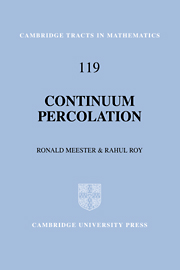Book contents
- Frontmatter
- Contents
- Preface
- 1 Introduction
- 2 Basic methods
- 3 Occupancy in Poisson Boolean models
- 4 Vacancy in Poisson Boolean models
- 5 Distinguishing features of the Poisson Boolean model
- 6 The Poisson random-connection model
- 7 Models driven by general processes
- 8 Other continuum percolation models
- References
- Index
1 - Introduction
Published online by Cambridge University Press: 05 November 2011
- Frontmatter
- Contents
- Preface
- 1 Introduction
- 2 Basic methods
- 3 Occupancy in Poisson Boolean models
- 4 Vacancy in Poisson Boolean models
- 5 Distinguishing features of the Poisson Boolean model
- 6 The Poisson random-connection model
- 7 Models driven by general processes
- 8 Other continuum percolation models
- References
- Index
Summary
Motivation for continuum models
Many phenomena in physics, chemistry and biology can be modelled by spatial random processes where the randomness is in the geometry of the space rather than in the random behaviour or motion of an object in a deterministic setting. As typical examples of the phenomena we have in mind, consider the spread of a disease in an orchard where the trees are arranged in a grid, and where the disease spreads from an infected tree to its neighbouring trees. In this example, the owner of the orchard is interested in the probability that a particular disease will eventually kill all the trees in the orchard. Another example is the process of the ground getting wet during a period of rain. The randomness here is the place where the raindrops fall on the ground and the size of the wetted region per raindrop. Finally, consider the spread of a disease in a forest. The infection is transmitted from one tree to another, which need not be in the vicinity of the infected tree. This is more likely to happen when the trees are closely spaced than when they are far apart. The collection of infected trees forms a random subset of trees in the forest.
The geometric structure of the first example is discrete, whereas in the next two examples, although the number of raindrops or trees is countable, the position of either is in the continuous space. A rigorous mathematical model to describe the first example is the standard discrete percolation model.
Information
- Type
- Chapter
- Information
- Continuum Percolation , pp. 1 - 20Publisher: Cambridge University PressPrint publication year: 1996
